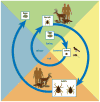The Blacklegged Tick, Ixodes scapularis: An Increasing Public Health Concern
- PMID: 29336985
- PMCID: PMC5879012
- DOI: 10.1016/j.pt.2017.12.006
The Blacklegged Tick, Ixodes scapularis: An Increasing Public Health Concern
Abstract
In the United States, the blacklegged tick, Ixodes scapularis, is a vector of seven human pathogens, including those causing Lyme disease, anaplasmosis, babesiosis, Borrelia miyamotoi disease, Powassan virus disease, and ehrlichiosis associated with Ehrlichia muris eauclarensis. In addition to an accelerated rate of discovery of I. scapularis-borne pathogens over the past two decades, the geographic range of the tick, and incidence and range of I. scapularis-borne disease cases, have increased. Despite knowledge of when and where humans are most at risk of exposure to infected ticks, control of I. scapularis-borne diseases remains a challenge. Human vaccines are not available, and we lack solid evidence for other prevention and control methods to reduce human disease. The way forward is discussed.
Keywords: Ixodes scapularis; control; disease; surveillance.
Published by Elsevier Ltd.
Figures






References
-
- Adams DA, et al. Summary of notifiable infectious disease conditions – United States, 2014. Morb Mortal Wkly Rep. 2016;63:1–52. - PubMed
-
- Burgdorfer W, et al. Lyme disease-a tick-borne spirochetosis? Science. 1982;216:1317–1319. - PubMed
-
- Dolan MC, et al. Vector competence of the blacklegged tick, Ixodes scapularis, for the recently recognized Lyme borreliosis spirochete Candidatus Borrelia mayonii. Ticks Tick Borne Dis. 2016;7:665–669. - PubMed
Publication types
MeSH terms
Grants and funding
LinkOut - more resources
Full Text Sources
Other Literature Sources
Medical
Miscellaneous

